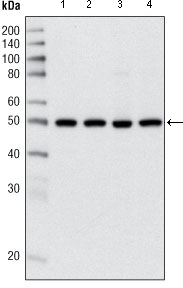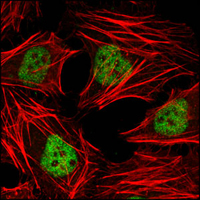HDAC3 Monoclonal Antibody
- Catalog No.:YM0327
- Applications:WB;IF;ELISA
- Reactivity:Human
- Target:
- HDAC3
- Fields:
- >>Neutrophil extracellular trap formation;>>Thyroid hormone signaling pathway;>>Alcoholism;>>Viral carcinogenesis
- Gene Name:
- HDAC3
- Protein Name:
- Histone deacetylase 3
- Human Gene Id:
- 8841
- Human Swiss Prot No:
- O15379
- Mouse Swiss Prot No:
- O88895
- Immunogen:
- Purified recombinant fragment of human HDAC3 (aa224-428) expressed in E. Coli.
- Specificity:
- HDAC3 Monoclonal Antibody detects endogenous levels of HDAC3 protein.
- Formulation:
- Liquid in PBS containing 50% glycerol, 0.5% BSA and 0.02% sodium azide.
- Source:
- Monoclonal, Mouse
- Dilution:
- WB 1:500 - 1:2000. IF 1:200 - 1:1000. ELISA: 1:10000. Not yet tested in other applications.
- Purification:
- Affinity purification
- Storage Stability:
- -15°C to -25°C/1 year(Do not lower than -25°C)
- Other Name:
- HDAC3;Histone deacetylase 3;HD3;RPD3-2;SMAP45
- Molecular Weight(Da):
- 49kD
- References:
- 1. Folia Biol (Praha). 2006;52(1-2):21-33.
2. Mol Cell Biol. 2007 Feb;27(4):1280-95.
3. Mol Carcinog. 2008 Feb;47(2):137-47.
- Background:
- Histones play a critical role in transcriptional regulation, cell cycle progression, and developmental events. Histone acetylation/deacetylation alters chromosome structure and affects transcription factor access to DNA. The protein encoded by this gene belongs to the histone deacetylase/acuc/apha family. It has histone deacetylase activity and represses transcription when tethered to a promoter. It may participate in the regulation of transcription through its binding with the zinc-finger transcription factor YY1. This protein can also down-regulate p53 function and thus modulate cell growth and apoptosis. This gene is regarded as a potential tumor suppressor gene. [provided by RefSeq, Jul 2008],
- Function:
- catalytic activity:Hydrolysis of an N(6)-acetyl-lysine residue of a histone to yield a deacetylated histone.,function:Responsible for the deacetylation of lysine residues on the N-terminal part of the core histones (H2A, H2B, H3 and H4). Histone deacetylation gives a tag for epigenetic repression and plays an important role in transcriptional regulation, cell cycle progression and developmental events. Histone deacetylases act via the formation of large multiprotein complexes. Probably participates in the regulation of transcription through its binding to the zinc-finger transcription factor YY1; increases YY1 repression activity. Required to repress transcription of the POU1F1 transcription factor.,PTM:Sumoylated in vitro.,similarity:Belongs to the histone deacetylase family. Type 1 subfamily.,subunit:Interacts with HDAC7 and HDAC9. Forms a heterologous complex at least with YY1. Intera
- Subcellular Location:
- Nucleus . Cytoplasm . Cytoplasm, cytosol . Colocalizes with XBP1 and AKT1 in the cytoplasm (PubMed:25190803). Predominantly expressed in the nucleus in the presence of CCAR2 (PubMed:21030595). .
- Expression:
- Widely expressed.
- June 19-2018
- WESTERN IMMUNOBLOTTING PROTOCOL
- June 19-2018
- IMMUNOHISTOCHEMISTRY-PARAFFIN PROTOCOL
- June 19-2018
- IMMUNOFLUORESCENCE PROTOCOL
- September 08-2020
- FLOW-CYTOMEYRT-PROTOCOL
- May 20-2022
- Cell-Based ELISA│解您多样本WB检测之困扰
- July 13-2018
- CELL-BASED-ELISA-PROTOCOL-FOR-ACETYL-PROTEIN
- July 13-2018
- CELL-BASED-ELISA-PROTOCOL-FOR-PHOSPHO-PROTEIN
- July 13-2018
- Antibody-FAQs
- Products Images

- Western Blot analysis using HDAC3 Monoclonal Antibody against HeLa (1), NIH/3T3 (2), C6 (3) and COS (4) cell lysate.

- Confocal immunofluorescence analysis of Hela cells using HDAC3 Monoclonal Antibody (green). Red: Actin filaments have been labeled with DY-554 phalloidin.



